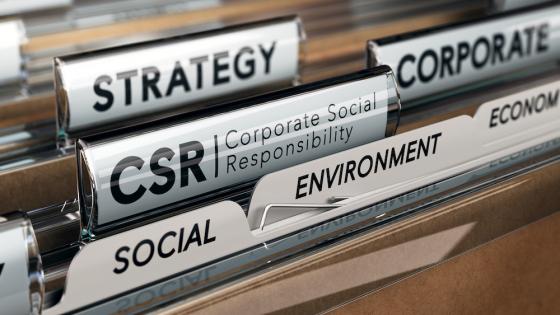It is often claimed that sustainability reduces a company’s cost of capital – i.e. the return it needs to offer its investors to raise funds. The logic seems straightforward. Sustainable companies are less risky, so investors require a lower return. And this logic seems to hold true in the real world – many practitioners point out how unsustainable companies have trouble raising financing.
Cash flows versus the cost of capital
But it is not actually that simple. Such arguments often confuse the effect of risk on a company’s cost of capital with its effect on a company’s expected cash flows. Let’s illustrate this distinction with an example.
Airline A runs on hydrogen, and its expected cash flows are £1 million per year, forever. Its cost of capital is 10%, so its value is £10 million. Assume that airlines can raise debt of up to half their value, so Airline A can raise £5 million of debt.
Airline B runs on conventional fuel. Its expected cash flows are also £1 million per year. However, there’s a 10% chance that the government implements a carbon tax which reduces its cash flows to zero (for simplicity). Thus, its expected cash flows are £900,000 per year. Assume that its cost of capital stays at 10%, so its value is £9 million and it can raise only £4.5 million of debt.
Thus, Airline B does have ‘trouble raising financing’. But this is nothing to do with its cost of capital being higher – it is exactly the same as Airline A’s. Instead, the difficulty comes purely from a cash flow channel. Airline B has trouble raising financing because risk reduces its cash flows, not because risk increases its cost of capital.
What determines the cost of capital?
Of course, sustainability might affect the cost of capital, not just cash flows. Finance 101 tells us that risk only affects the cost of capital if it is systemic (shared by the rest of the market) and not if it is idiosyncratic (specific to that firm in question). It is not a foregone conclusion that sustainability affects systemic risk. For example, whether the government implements a carbon tax might be due to action from a pressure group, or new evidence on the seriousness of climate change, and these events have nothing to do with the economy.
The same is true for other aspects of sustainability. It is often argued that sustainable companies have a purpose beyond profit, and so are less likely to suffer scandals caused by excessive focus on profit – such as banks opening fake customer accounts or mis-selling payment protection insurance. But whether banks get caught for such actions depends on the effectiveness of the regulator, not the state of the economy.
Indeed, there are plausible reasons why unsustainability might decrease systemic risk – unsustainable companies might suffer cash flow shocks, but they occur in economic upswings where investors do not need the cash so much.
- In an excellent survey paper on climate risk, Giglio et al. (2020) show that if the main risk is about the path of the economy, then unsustainable companies might have a lower cost of capital. It’s more likely the government implements a carbon tax when the economy is booming, since economic activity leads to high emissions and thus the need for a tax. Since Airline B is now countercyclical – it does poorly in good times – its cost of capital falls to 9.5%. Its value is £9.5 million – still less than Airline A because of its cash flow risk – but the value erosion is less due to the countercyclicality.
- Moving beyond climate, it might be more likely that banks will open fake accounts or mis-sell payment protection insurance in good times – there’s an even stronger incentive to grab that extra piece of the market when it’s large.
- The above examples view sustainability as risk mitigation – providing downside protection. Another approach is to view it as providing upside value creation, like any intangible asset. For example, ‘purposeful’ companies may have more motivated employees and loyal customers. However, intangible assets are risky since, in a downturn, they have less value than physical assets. While companies can sell their buildings and factories, they can’t sell their corporate culture or customer loyalty. If so, then sustainable companies have a higher cost of capital.
Why sustainability might reduce the cost of capital
On the other hand, there are valid arguments for why sustainability might reduce the cost of capital. The point of this column is not to argue that sustainable companies definitely have a higher cost of capital, but to point out that it’s not automatic which direction any effect will be. Let’s consider some of these arguments:
- Starting again with climate, Giglio et al. (2020) show that, if the main uncertainty is not about the path of the economy but the path of climate change (the likelihood of a climate disaster), Airline B suffers in a climate crisis where most other companies are also suffering. Then, if its cost of capital is 10.5%, its value is £8.6 million – even less than if there were no cost of capital impact.
- The risk of scandals might be higher in bad times, if companies are desperate for cash and tempted to engage in immoral behaviour. Likewise, public trust in business as a whole is low during bad times, but sustainable companies retain such trust, as Lins et al. (2017) document.
- One explanation unrelated to risk is the supply of capital. Some investors may boycott unsustainable companies, such as fossil fuel stocks. However, it’s not clear that this will have a meaningful impact on the cost of capital since, to sell, another investor has to buy. Indeed, energy funds are natural buyers. More generally, there are many types of companies that are not held by certain investors, but they are not deprived of capital as other investors step in. Dividend-paying stocks are underweighted by growth funds but bought by income funds. However, there will be supply effects that impact the cost of capital if there’s a large preference for sustainable companies across the investment industry.
Why this matters
Overall, it is not so clear-cut whether sustainability increases or reduces the cost of capital. But it may seem that this doesn’t matter. Airline B is worth less than Airline A in every case (£9.5 million if its cost of capital is lower, £9 million if it’s the same, and £8.6 million if it’s higher – compared to £10 million for Airline A). If the punchline stays the same – sustainability is valuable – does it really matter whether it’s because of ‘higher expected cash flows’ or a ‘lower cost of capital’? Is there really any harm in statements such as “sustainable companies have lower cost of capital”? It may be academically imprecise, but practically it has the same outcome.
In fact, this confusion has important practical implications:
- It is very hard to estimate the cost of capital (at least for equity capital). The expected returns that shareholders expect when they buy a stock are unknown. We observe the realised returns that they receive ex post, but high realised returns could either result from high expected returns (the cost of capital channel) or high unexpected returns (the cash flow channel).
In Edmans (2020), I explain how several measures of sustainability are correlated with high realised returns and these seem to be at least partially unexpected, consistent with the cash flow channel. This research complements Edmans (2011), where I find that companies with high employee satisfaction generated earnings that systematically beat analyst expectations.
In short, the channel is important for the evidential underpinning. There is no consensus that sustainable companies have a lower cost of equity. The evidence for the cost of debt is also mixed, as shown by Halling et al. (2021).
- If sustainability did reduce the cost of capital, then sustainable companies should produce lower returns going forward. Indeed, Pastor et al. (2020) model the ‘supply of capital’ channel and show that sustainable companies will attract demand from sustainable funds, pushing up their stock prices and lowering their future returns – inconsistent with the common claim that sustainable investing leads to higher returns. Conversely, unsustainable companies will enjoy higher expected returns. Indeed, Hong and Kacperczyk (2009) indeed found outperformance of sin stocks over a 42-year period.
- If sustainability reduces the cost of capital, then sustainable companies are counter-cyclical. This suggests that sustainability is not as important in good times. Under the cash flow channel, sustainability is always important.
- A major determinant of the cost of capital is risk aversion – this is why investors charge a higher cost of capital to risky companies. Evidence supports the idea of ‘decreasing risk aversion’ – wealthier investors are less risk-averse. Thus, the largest investors (such as sovereign wealth funds), with the greatest potential to hold companies to account for embedding sustainability, may be the least concerned with systemic risk. In contrast, all investors – regardless of their risk aversion – are concerned with cash flows.
Of course, large investors may be more concerned with sustainability than small investors for different reasons – for example, they are ‘universal owners’ whose portfolios will be more affected by the externalities from climate change. However, this is an externality channel, not a cost of capital channel.
So, do sustainable companies enjoy a lower cost of capital? The jury is still out – and, if they do, it might mean lower investor returns, less attention from risk-tolerant investors, and less attention in good times. As a result, it’s important to be careful of making such claims without rigorous evidence.
References
Edmans, A (2011), “Does the stock market fully value intangibles? Employee satisfaction and equity prices”, Journal of Financial Economics 101: 621–40.
Edmans, A (2020), Grow the pie: How great companies deliver both purpose and profit, Cambridge University Press.
Giglio, S, B Kelly and J Stroebel (2020), “Climate finance”, Annual Review of Financial Economics, forthcoming.
Halling, M, J Yu and J Zechner (2021), “Primary corporate bond markets and social responsibility”, SSRN Working Paper.
Hong, H and M Kacperczyk (2009), “The price of sin: The effects of social norms on markets”, Journal of Financial Economics 93: 15–36.
Lins, K, H Servaes and A Tamayo (2017), “Social capital, trust, and firm performance: The value of corporate social responsibility during the financial crisis”, Journal of Finance 72: 1785-1824.
Pastor, L, R F Stambaugh and L A Taylor (2020), “Sustainable investing in equilibrium”, Journal of Financial Economics, forthcoming.



